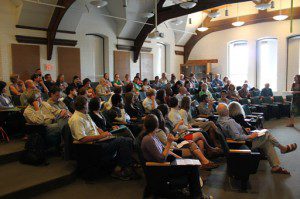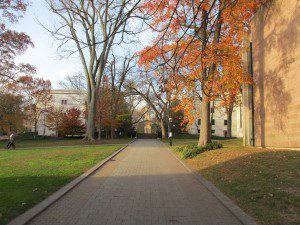 Saw this in a terrific piece on class lecturing at The Atlantic. In an age gravitating toward online education, essays like this deserve careful consideration. Richard Gunderman, a professor at Indiana University, offers these thoughts on the unique contribution of a live, personal lecture:
Saw this in a terrific piece on class lecturing at The Atlantic. In an age gravitating toward online education, essays like this deserve careful consideration. Richard Gunderman, a professor at Indiana University, offers these thoughts on the unique contribution of a live, personal lecture:
The core purpose of a great lecturer is not primarily to transmit information. To this end, other techniques, such as assigning a reading in a textbook or distributing an electronic copy of the notes, can be equally effective. The real purpose of a lecture is to show the mind and heart of the lecturer at work, and to engage the minds and hearts of learners. Is the lecturer enthusiastic about the topic? Why? Could I get enthused about this, too? How could I use this to take better care of my patients? Is this the kind of doctor or nurse I aspire to be some day?
I could not agree more with Gunderman, who works in very different fields–like radiology and pediatrics–than I do. I think the goal of a college lecturer is to electrify and enlighten students. Actually, let’s collapse that. The goal is enlightenment through electrification. In other words, yes, the classroom could be boring; it could be needless; you could get its offerings elsewhere. But here, in this particular classroom, learning is on fire. Students who come in sleepy and bored leave stirred and informed.
Let’s be clear: if the classroom is not engaging, I actually think something is going wrong. Professors may well find themselves out of work in coming days if this is true due to pressure from emerging educational markets. It behooves us all in this age to bring everything we have to our lectures. But don’t mistake my point. I don’t mean that the manner of every professor must be “exciting” or “entertaining.” Some of the most engaging material I’ve encountered wasn’t shouted or displayed next to shiny pictures. It was thoughtfully delivered, with profundity of thought and concision of expression. It was like a stone sanded down by long-running streams.
Do you doubt my point? Do you think that actual pyrotechnics, and silly stunts, are needed to engage modern young people? I don’t think so. I think of a preacher like Tim Keller (not a professor, though he was one and would be a splendid one). He’s a great speaker, but he doesn’t shout. He doesn’t whirl around on stage. He doesn’t use Powerpoint. He offers people profound exposition of Scripture. He’s like Lloyd-Jones in that respect, or dare I say Jonathan Edwards. Edwards is only the leading theologian and philosopher of the American tradition, and he rarely varied his pitch in the pulpit. He was, you might say, a bit dry. But if you actually engaged with his material, you found yourself blasting through the biblical-theological stratosphere, hanging on for dear life as this man sent you soaring intellectually and spiritually.
In fact, that holds today, though we can’t hear him lecture. His writings send us into the cosmos on errands of theistic illumination. But doesn’t that prove the point? How much better to hear him, to see him, to ask questions of him, to get to know him even a little, to see how he handles his verbal missteps, to have the unique privilege to be in the presence of a master-thinker?
All this to say: professors can lecture in many different styles. Whatever their style, they should give the lecture all they have. They should display profundity of thought and speech. They should weave a kind of magic, the magic of the cosmos revealing itself to young minds, in their classes.
This is what the lecture has done for centuries; this is what it will continue to do, where schools do not make the huge mistake of doing away with it, and where professors do not mail it in but gear their classes toward discovery, and illumination, and enlightenment of this world God has made.
(Image: Bowdoin Daily Sun)











